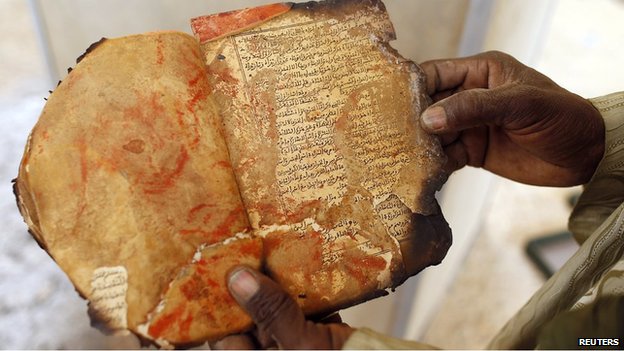The images of scattered and torched storage boxes at the Ahmed Baba Institute in Timbuktu raised fears that thousands of the city’s famous manuscripts had been destroyed towards the end of Islamist rule.

Since Islamist militants were driven out of urban centres in northern Mali by French-led forces, there have been conflicting reports about the documents in Timbuktu, some of which date back to the 10th Century.
However, the majority of the manuscripts in the new South African-funded institute appear to have been protected.
South African researcher Mohamed Mathee, who is part of the Timbuktu Manuscripts Project, has been to Mali five times in the last decade.
He admits that he and his colleagues were extremely worried when the militants took control of Timbuktu last year.
However, the most recent communications with Mali have brought reassuring news.
“What we’ve heard from reliable contacts in Bamako is that most of the manuscripts are fine, they’ve not been harmed,” he said.
“I don’t think the loss is as great as has been reported because most of the manuscripts had been moved and taken to safety, long before the events of the past two weeks.”
Digitally saved
According to Mr Mathee, the people of Timbuktu have a centuries-old tradition of protecting and preserving their manuscripts.
“They think on their feet when faced with these challenges,” he says.
“They take the documents to family homes and store them safely.”
In recent years, thousands of the library’s documents have been restored and digitally saved – it was a project expected to take many years.
The researchers based in South Africa can now pursue their work by computer, as they view digitised images of the manuscripts.
Their academic work in Mali stems from a ground-breaking visit by former South African President, Thabo Mbeki, in 2001.
Mr Mbeki promised that the South African government would help Mali to conserve the thousands of manuscripts held in Timbuktu at the Ahmed Baba Institute.
The timing of Mr Mbeki’s commitment coincided with his ambitious plans for a so-called “African Renaissance”.
Myth and legend
The Ahmed Baba Institute in Timbuktu houses between 30,000 and 40,000 manuscripts, but Mr Mathee says many of them had been moved before Islamist rebels occupied the city in April 2012.
“Empty boxes are not proof that the papers have been burned and destroyed.”
The South African researchers believe about 2,000 manuscripts may have been lost during the turmoil of the past year.
But it seems this city of myth and legend has managed to preserve the majority of its ancient treasures.
“They are what defines Timbuktu,” says Mr Mathee.
“The idea of the archival library was to preserve the manuscripts – not only in times of war, but also from the danger of fire and the natural elements.
“We want the world to be interested in this ‘knowledge tradition’, and we want to show it in a more tangible way.”





